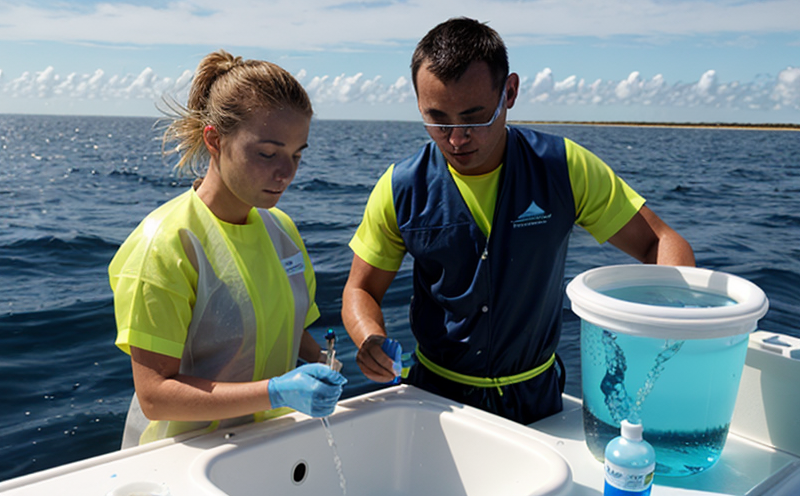EPA 1664 Hexane Extractable Material Oil and Grease Test in Seawater
The EPA 1664 method is a critical tool for the analysis of hexane extractable materials from oil and grease in seawater. This test is essential for environmental monitoring, especially in regions where industrial activities, such as shipping ports or offshore drilling sites, may contribute to pollution. The method provides insights into the presence and concentration of hydrocarbons that could affect marine ecosystems.
The hexane extractable material (HEM) represents a broad fraction of the total petroleum-like substances found in seawater. These materials can originate from various sources including petroleum products, biodegraded oil, or other organic compounds. Understanding the composition and concentration of these materials is crucial for assessing environmental impacts and compliance with regulatory standards.
The EPA 1664 method involves extracting HEM from a sample using hexane under specific conditions. The extracted material is then analyzed to determine its components. This process requires precise laboratory techniques and specialized equipment, including a Soxhlet extractor and a gas chromatograph equipped for the analysis of petroleum hydrocarbons.
The importance of this test lies in its ability to provide quantitative data on oil and grease contamination levels. Such information is vital for regulatory compliance, environmental impact assessments, and risk management strategies. The method is widely used by governmental agencies, environmental consultants, and industries with significant maritime operations.
Compliance with EPA 1664 is not only a legal requirement but also an essential step in maintaining the integrity of marine ecosystems. By ensuring that seawater meets regulatory standards for oil and grease content, stakeholders can minimize harm to aquatic life and support sustainable environmental practices.
The method's accuracy and reliability are underpinned by its alignment with international standards such as ISO 16005-2. This standard provides a framework for the determination of hydrocarbon compounds in seawater, ensuring consistency across different laboratories and jurisdictions.
In summary, EPA 1664 is a robust method that supports environmental stewardship by providing quantitative data on oil and grease contamination in seawater. Its application ensures compliance with regulatory standards and contributes to the protection of marine ecosystems.
Scope and Methodology
| Aspect | Description |
|---|---|
| Sampling | Seawater samples are collected from designated locations using standardized sampling techniques. Samples should be representative of the area being monitored. |
| Extraction | Hexane is used to extract HEM from the seawater sample under controlled conditions to ensure accurate representation of oil and grease content. |
| Analysis | The extracted material is analyzed using a gas chromatograph equipped with a flame ionization detector (FID) for quantification. |
| Parameter | Acceptance Limit (mg/L) |
|---|---|
| Total Hexane Extractable Material (HEM) | ≤15 mg/L |
| Petroleum Hydrocarbons, C6-C9 | ≤30 μg/L |
Benefits
The EPA 1664 test offers several key benefits for stakeholders involved in environmental monitoring and compliance:
Data Accuracy and Reliability: The method aligns with international standards, ensuring consistent and reliable data across different laboratories.
Compliance Assurance: By providing quantitative data on oil and grease contamination levels, the test supports regulatory compliance and helps avoid legal penalties.
Risk Management: Early detection of contamination allows for proactive management strategies to mitigate environmental risks.
Sustainable Environmental Practices: The information provided by this test can be used to develop sustainable practices that minimize harm to marine ecosystems.
Scientific Insight: Detailed analysis provides insights into the sources and impacts of oil and grease contamination, contributing to scientific understanding.
Competitive Advantage and Market Impact
The ability to perform accurate and reliable EPA 1664 tests positions a laboratory as a leader in environmental monitoring services. This expertise is highly valued by industries with significant maritime operations, such as shipping, offshore drilling, and coastal tourism.
By offering this service, laboratories can differentiate themselves through their technical capabilities and compliance knowledge. This competitive advantage translates into higher client satisfaction and increased market share. Clients can trust that the laboratory provides accurate data essential for making informed decisions about environmental impact and compliance strategies.
The demand for such services is growing as regulatory standards become more stringent, and public awareness of environmental issues increases. Laboratories that excel in EPA 1664 testing are well-positioned to meet this demand and contribute positively to the environment.





